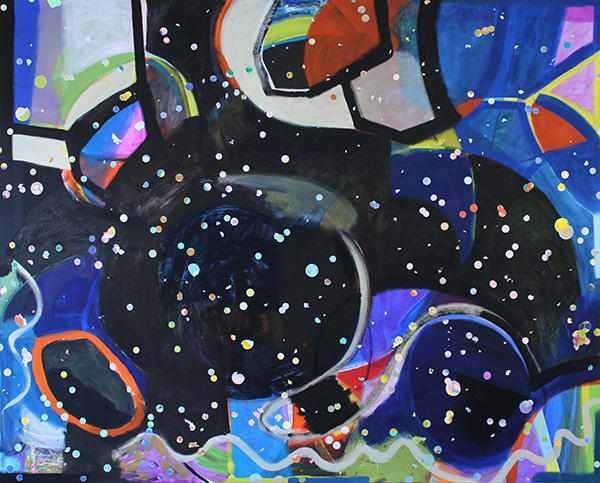The apartment on Central Park West is crowded. Jonathan DePeri ’07CC stands beside his baby grand and asks for quiet. In a moment he will accompany a young soprano in an aria from Verdi’s Falstaff, but first he welcomes the mathematician whose abstract paintings cover his walls. “Ladies and gentlemen, it is my pleasure to introduce Helena Kauppila.”
Thirty-odd guests applaud. They sit on DePeri’s white, L-shaped couch, stand by his bookcase (Homer, Shakespeare, economics), and hover near the food table. Some stand outside on the seventeenth-floor balcony, overlooking the fluffy greenery of Central Park, and peer in through the triptych of windows.
Kauppila ’10GSAS thanks the audience and DePeri. Her blond hair is pulled back tight. Her eyes are a hypnotic crystal blue. She gestures to the walls. “I have brought together paintings from various series that explicitly have a mathematical theme,” she says. “I’ve used probability distribution as a tool in the paintings, conceptually and aesthetically.”
In statistics, probability distribution assigns probability to all possible measurable outcomes of a random process. Kauppila wants the dispersal of objects in her paintings to be as arbitrary as the scattering of stars in the galaxies, or microbes in water, or flowers in the fields. Sometimes, before she paints, she’ll spin around the room of her Brooklyn studio, making a whirlwind of the paint-pocked cement floor, the coffee cans thick with paintbrushes, the color-drunk canvases, and, out the window, the great tower of the Manhattan Bridge draped in its steel ropes. To achieve randomness she must disorient herself: the mind is always making patterns, even when it tries not to.
In DePeri’s living room, Kauppila stands still and lets the other heads spin as she describes her method. She points to Mangroves, in which turquoise dots speckle a thick net of ultramarine, evoking the ocean as “a treasure trove of information.” A larger canvas nearby is a study of Kauppila’s palette: hundreds of small, tile-like squares of varying colors (the hot reds blazing like triple-word scores) whose placement was determined randomly by computer, allowing Kauppila to avoid any distracting compositional elements. “When I destroyed the composition,” she says, “one could see color for its properties.”
DePeri, who wears jeans and a blue shirt and has dark, wavy hair, is an arts lover — he studied piano at the Manhattan School of Music before transferring to Columbia — and has long been interested in arts philanthropy. When he moved to his apartment in 2013, and considered what he could do with the space, he hit on what he now calls the Gotham Arts Salon: artistic and musical gatherings that blur the line between private and public. “Anyone who’s invited can invite others,” he says, reveling in the quantitative — and qualitative — possibilities. “I have no desire to direct how the social composition of the group develops. I just curate the events, make sure there’s a standard of quality, and hope that people return.”
Kauppila is on the balcony. The sun drops behind a new high-rise on Columbus Avenue, the sky deepens to computer-screen blue, and the buildings on the far side of the park pulse with electricity. People, some of them young art collectors, surround Kauppila, drawn to the ray of her intellect, which alone seems to validate her artwork, or at least heighten the interest in it. For the past four years, Kauppila has taught in the Mathematics of Finance master’s program at Columbia, giving students “a foundation in the mathematical structures behind derivatives, so that they can analyze relationships between the prices of products.” If they want, students can build on these principles to create profitable trading strategies in the stock market.
“All stocks are random, their outcomes unknown,” Kauppila says. “The big philosophy behind my painting is that the outcome is unknown. I don’t know where some specific dot of color is going to go, but I don’t want to know, because what I want is randomly spread-out color.”
She can trace this desire back to her childhood in Finland, where she spent summers on the tiny islands of the Finnish archipelago, surrounded by the Baltic Sea. She fished, she swam, but what she loved most was staring at the water, at the light twinkling on the surface. “Those patterns, that meditative state, the association of water with a kind of focused, expansive condition, enters into my work a lot,” she says. “I use random distribution to capture the energy of immersive environments.”
Here’s some more randomness: Kauppila and DePeri first met last March, at the third installment of the Gotham Arts Salon (tonight is the fourth). Kauppila had come with a friend, and she and DePeri got to talking. When DePeri heard that Kauppila received her PhD in probability theory, a chord was struck: at Columbia, DePeri had gravitated to economics, statistics, and math. He ended up majoring in computer science.
Now he works in quantitative portfolio management, which, he says, “is really big-data analysis: inferring patterns from large, varied data sets in order to make more effective investment decisions.”
Perhaps, then, the DePeri–Kauppila pairing was in the stars.
Certainly Kauppila’s latest painting can claim stellar origins: an eight-foot-by-ten-foot canvas titled Data, Disorientation, the Big Bang, called up on an iPad, shows hundreds of celestial orbs flung in the cosmic graffiti of deep space. “This is the portion of the sky that the Kepler space telescope is scanning,” Kauppila says. “My original inspiration was the data coming from telescopes. I was fascinated by how much data we’ve acquired — a full 3D map of the nearby universe, several hundred light years out.”
By the time Kauppila started the painting, the Kepler telescope had detected hundreds of exoplanets — planets outside our solar system — some of them located in what NASA calls “habitable” proximity to Sun-like stars.
That news sent Kauppila’s mind rotating rapidly on its axis.
“I wanted to merge these scientific facts about space with the perspective of an observer on another planet,” she says, as a sprinkle of stars becomes discernible high above Central Park. “The art component of the painting resides in the unknown. The artist doesn’t have to prove a theorem. The artist is free to do something more personal: pretend you’re just elsewhere in the universe, and that this is your perspective of the night sky.”



